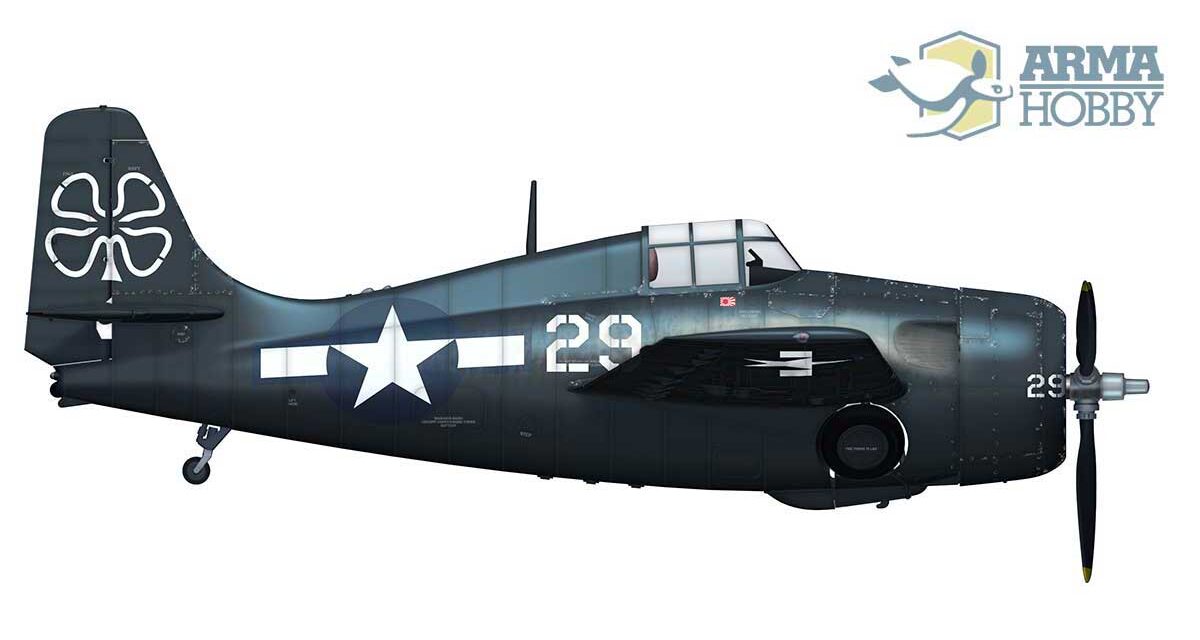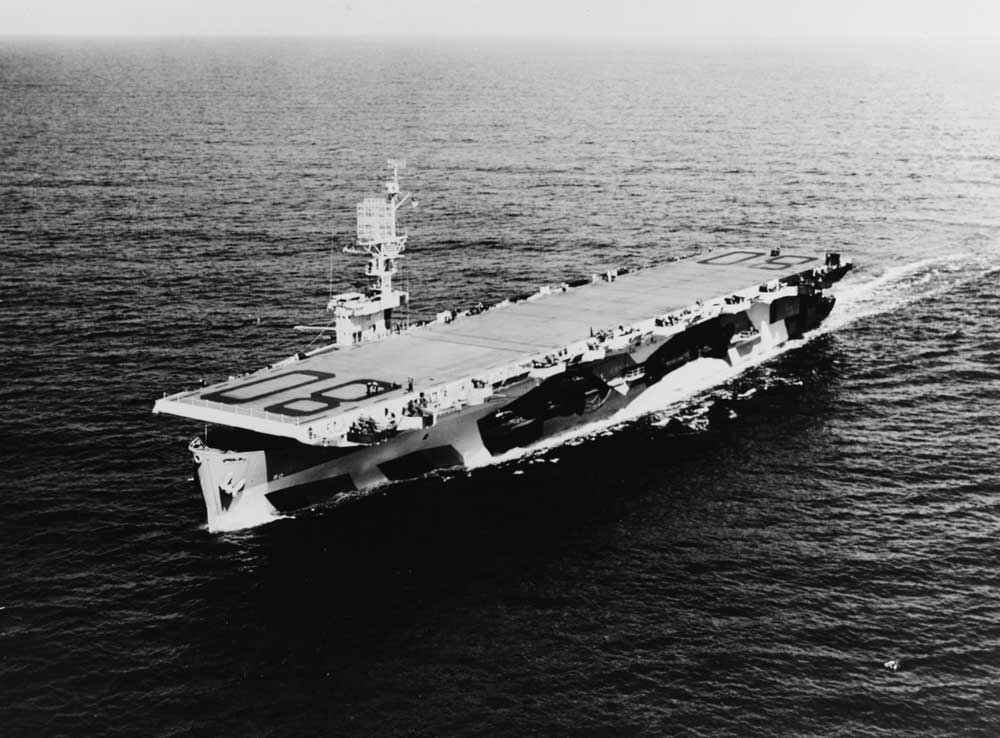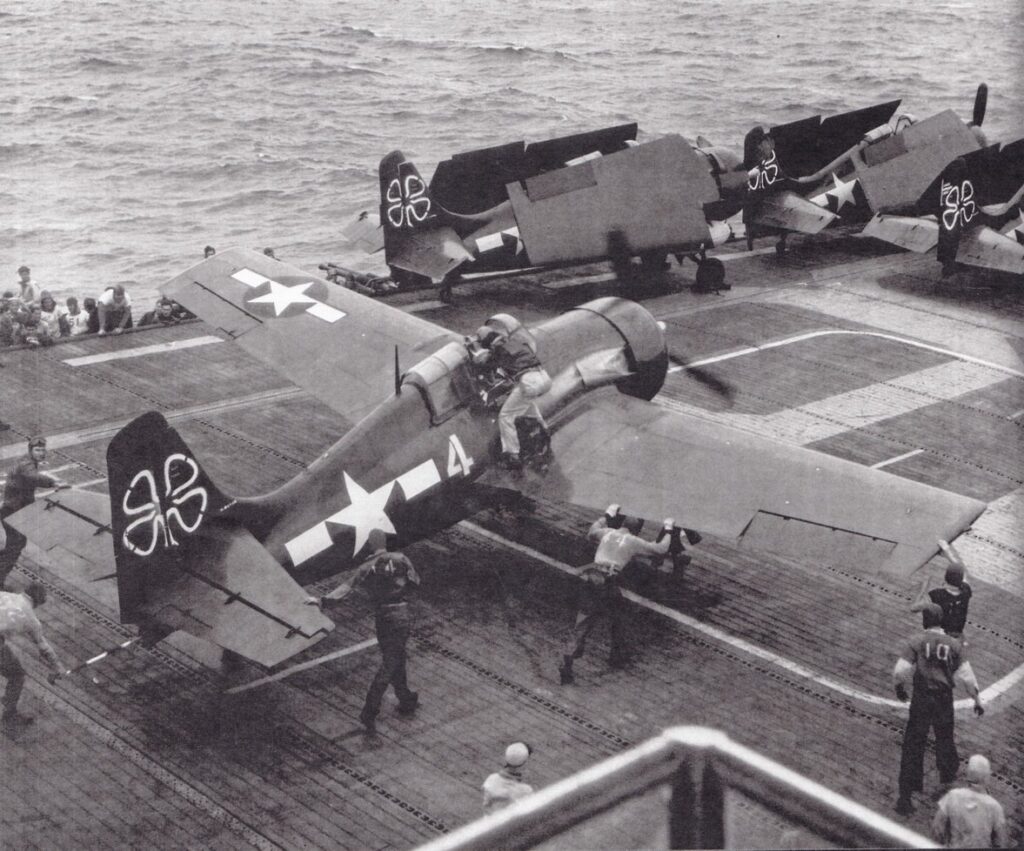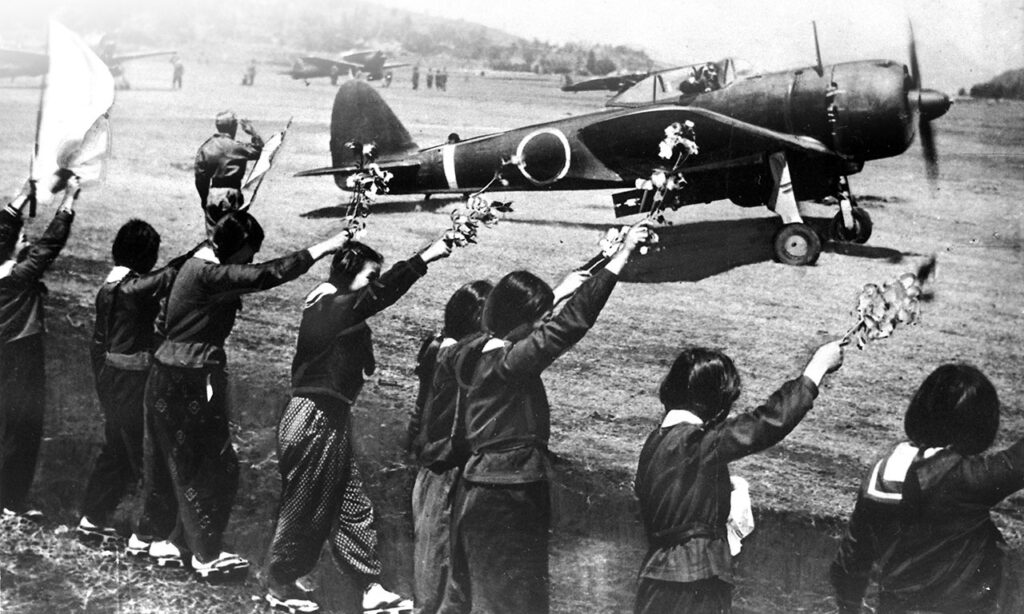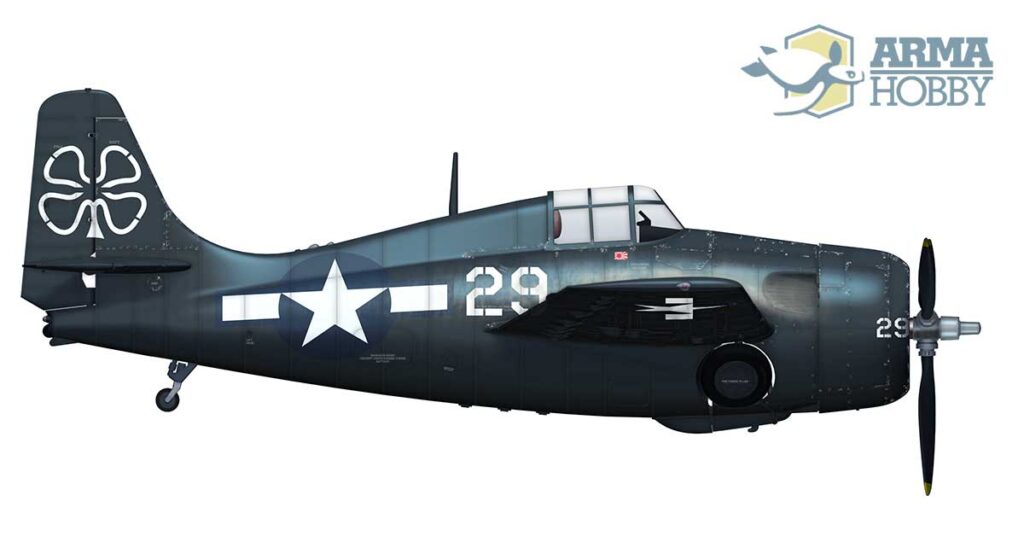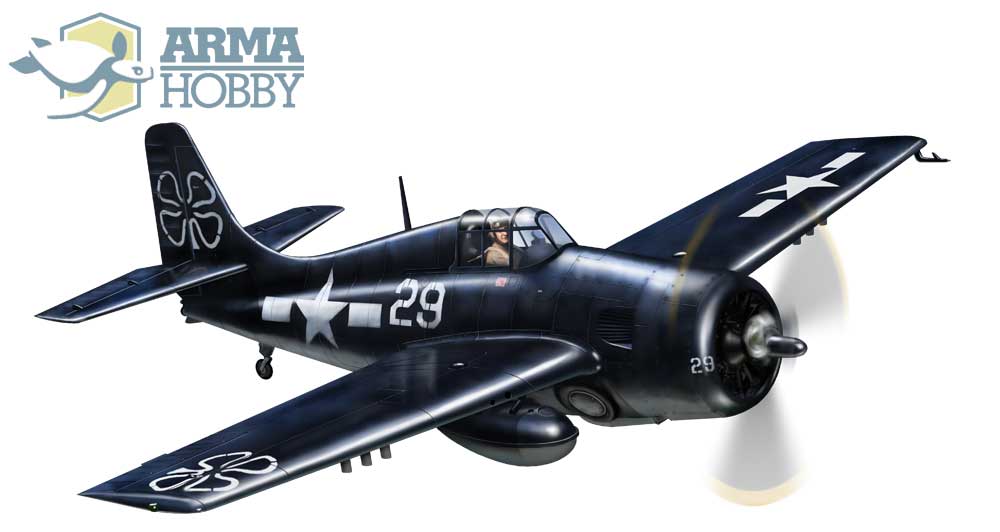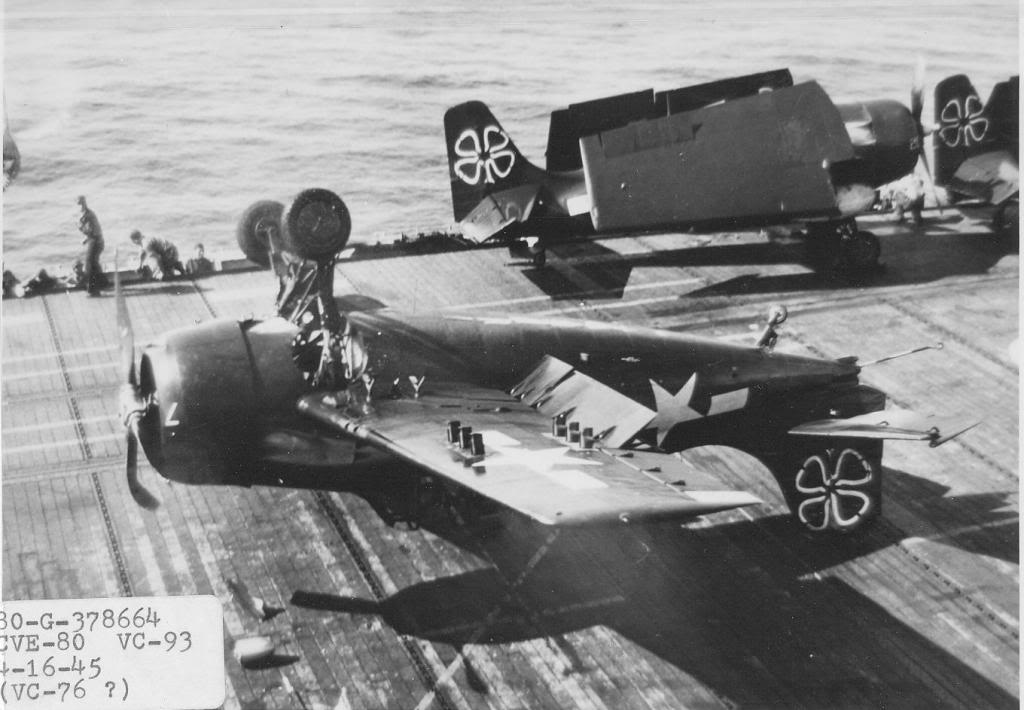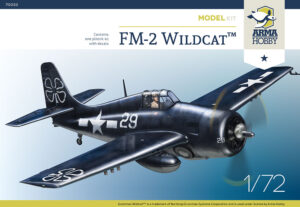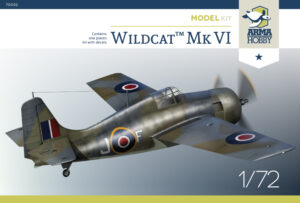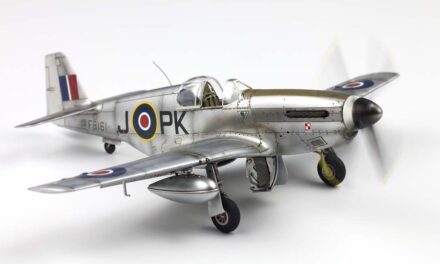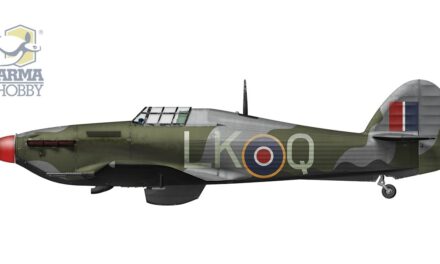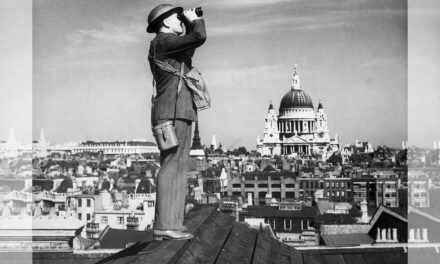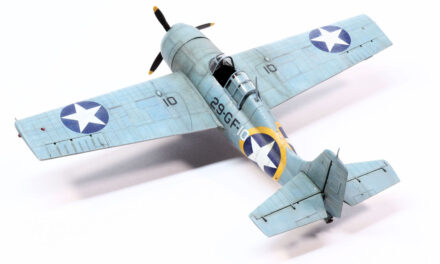The Battle of Okinawa was the last decisive sea battle during the war in the Pacific. During the struggle, US Navy escort carriers had to deal with waves of Kamikaze. Meanwhile, US Navy fleet carriers sank Yamato – the biggest battleship of the Imperial Japanese Navy. USS Petrof Bay and its aircraft adorned with a four-leaf clover had its finest hour
USS Petrof Bay
CVE-80 USS Petrof Bay belonged to the Casablanca Class escort carriers, commissioned on 18th February and at the beginning, its main task was to transport aircraft and personnel in the Pacific. After her return to San Diego in May 1944 the ship embarked its air arm – the Composite Squadron VC-76 which consisted of TBM Avenger torpedo-bombers and FM-2 Wildcat fighters. Since September it took part in four operations. Three of them were bloody US Marines assaults on Peleliu (September 1944), Iwo Jima (February 1945) and the last big sea battle of the war – Okinawa (April 1945). Main tasks included aerial support of ground forces and air patrols against enemy air and sea attacks. A bit different situation occurred during the Battle of the Philippines when the carrier not only conducted typical air support for US Marine Corps, but also took part in the battle with Kurita’s battleships near the island of Samar on 25th October 1944.
USS Petrof Bay (CVE-80) 21 June1944, Eastern Pacific, photo US Navy.
The Battle of the Philippines
We have already described the history of the Battle off Samar in the story about USS Gambier Bay. It was the climax of the Battle of the Leyte Gulf. Japanese navy sent four task groups to destroy the invasion force. At that time, USS Petrof Bay was a part of Taffy 1 group that wasn’t within the range of Japanese guns, but that day was very busy for the crew. In the morning, the torpedo from I-56 submarine hit other Carrier of the group, the USS Santee. The next day, American ships had to counter the attacks of Japanese aircraft from the Philippines.
Meanwhile, the aeroplanes from VC-76 supported other squadrons of theTaffy 1 in attacks on Japanese ships. Later that day, USS Petrof Bay had to outmanoeuvre two torpedoes launched by the I-56. That attack finished the hardest day in the ship history. The liberation of the Philippines continued, but for some time USS Petrof Bay wasn’t involved in air support. It escorted convoys with supplies for ground forces. The carrier aircraft appeared over the battlefield again in December during the invasion of Mindoro and in January 1945 during the invasion of Luzon when the crew saw kamikaze attack which sank USS Ommaney. Later an American destroyer scuttled the burning carrier with a torpedo. After the USAAF took over the aerial control of Luzon on 17th January 1945, the escort carrier Task Group left the area of combat.
Japanese Imperial Fleet disposition 25th October 1944, 1050 AM, during VC-76 attack. In the center of the formation are two TBF-1c: Cdr James W. McCauley and Ens. Noah Butt Jr attacking on Yamato. Sketch by Mc Cauley, National Archives via Rick Cline.
Iwo Jima
Iwo Jima, the island 650 miles south of Tokyo, was another target in the American leapfrogging strategy. The invasion started on 19th February 1945. The airfield on the island was going to be the base for P-51D Mustang fighters which escorted B-29 bombers that took off from the Marianas, further south. The island was heavily defended by the Japanese Army, and air support was necessary. In addition to attacking ground targets, the VC-76 aircraft flew combat air patrols and anti-submarine (ASP) patrols. The Kamikaze attacks were becoming stronger, and one of their victims was USS Saratoga attached to the escort carrier task group, hit by four aircraft. Another victim was USS Bismarck Sea, which sunk. USS Petrof Bay didn’t lose any aircraft, but it also didn’t gain any success. After the battle, the ship replaced VC-76 Composite Squadron with VC-93. With a new composite squadron, the ship took part in the battle of Okinawa.
FM-2 Wildcat, aeroplanes from the VC-93 squadron on flight deck of the USS Petrof Bay, 25 March 1945, preparation for invasion on Okinawa. Aeroplane in the backgroud with one white painted fuel tank underwing. FM-2 Wildcats usually carried only one of them.
Okinawa – the Last Clash
Okinawa, an island in the Ryu-Kyu archipelago, was the last battle in the American leapfrogging campaign before the invasion of Japan. It was also the first target which administratively belonged, as a separate prefecture, to the Empire. The island lies 340 nautical miles south of the western end of the home islands. The invasion started on 1st April 1945, but the bombardment had started a few days earlier. As might be expected, this provoked a counterattack by the last forces of the imperial fleet, with the battleship Yamato. Americans sent fleet carriers to destroy the Japanese fleet. Beside supporting ground forces, US escort carriers had to face the waves of Kamikaze attacks.
Shortly before the invasion, there was an accident on the hangar deck of USS Petrof Bay. Armourer, AOM Manford K. Withmer, accidentally pressed the trigger while he was cleaning machine guns. Wildcat had its wings folded, and bullets penetrated the deck and injured four seamen who were eating in a mess below. For his negligence, he was demoted one grade and got 150$ fine. This show how dangerous is the service on aircraft carriers.
The most successful fighter pilot of the VC-93, Lt (jg) Heatherly Foster flew also TBF-1c Avenger. On the phot with his crew: S. Orlowski (gunner) & ARM/1c Roger W. Goodwin. Photo Bill Gonyo/NavSource.
Defeat the Kamikaze
Kamikaze, „the Divine Wind”, was a tactic of suicide air attacks and its name referred to the thirteenth-century typhoon that destroyed the Mongol invasion fleet. The Japanese Navy decided to use it after it had lost the best pilots and aircraft carriers in 1942, 1943 and 1944 during heavy combat. The Japanese sent less trained pilots to battle escorted by veteran pilots. The first Kamikaze attacks took place in October 1944 during the Battle of the Philippines. But the peak of Kamikaze attacks was the Battle of Okinawa when the Japanese sent more than 1500 airplanes in total. At that time, Kamikaze was no longer just an auxiliary weapon, but one of the main measures to fight the enemy.
Fighting Squadron Three (VF-3) and “Jimmy” Thach in the Battle of Midway
The defence tactics against Kamikaze was invented by Cmdr. Jimmy Thach. He was the famous commander of VF-3 from USS Yorktown in the Battle of Midway. In the battle six F4F-4 Wildcat lead by Thach were able to fight 15-20 Zero fighters using “Thach weaver” manouvers. After the battle he was promoted to train new pilots in his tactics. His “Big Blue Blanket” tactics increased situational awareness of the fleet supportig landing operation. The carrier-controlled interception wasn’t enough anymore, and the US Navy had to see further than the radar range of its biggest ships. The outer guard ring, 50 miles from the invasion forces, consisted of 15 destroyer pickets. Each of them had an air control radar that allowed destroyers to detect enemy aircraft approaching from the Home Islands. They became first kamikaze targets, and that’s why they had the additional support of destroyers and modified landing crafts equipped with heavy anti-aircraft artillery. The escort carriers provided air support. Most of 11 destroyers sunk during the Battle of Okinawa were those from pickets.
Chiran high school girls are waving farewell with cherry blossom branches to a taking-off kamikaze pilot. The pilot is Second Lieutenant Toshio Anazawa of Army Special Attack Unit (20th Shinbu party). The aircraft, an Army Type 1 Ki-43 fighter “Hayabusa” III- type-Ko holding a 250kg bomb, is departing towards Okinawa on April 12, 1945. Photo: Wikipedia.
The attacks were most severe on 6th April during Operation Ten-Go, when battleship Yamato was sailing towards Okinawa, and on 12th April. On both those days, the Wildcat pilots from the USS Petrof Bay successfully fought attacks by suicide pilots.
6th April 1944
At around 13.30 that day, four FM-2 Wildcats from USS Petrof Bay got into position over Ie-Shima island. Mission that was supposed to be just a typical air patrol turned out to be a battle with 335 bombers, fighters and Kamikaze sent to attack the invasion fleet.
The first pilot who got into action was Lt (jg) Heaterly Foster. He was one of six VC-93 Avenger pilots who also learnt to fly Wildcats. In his initial fight, he shot down one Aichi D3A Val dive bomber that was heading down to attack an escort carrier. Then the whole American section clashed with a group of A6M Zero fighters and Lt Robert Meyers and Lt (jg) James Tuttle shot down one fighter each. At the same time, Foster and section’s fourth pilot, Lt (jg) Donald Sherlock unsuccessfully opened up on other Zeros. However, soon Sherlock got his own back and shot down a D3A Val that was diving towards American ships. But the combat wasn’t over. Lt Meyers, VC-93 second-in-command, noticed another Zero flying low at 500 feet. He pressed home the head-on attack and shot it down. A moment later, when he was climbing back to combat attitude, he saw another Val diving towards a destroyer. Unmindful of anti-aircraft shelling, he attacked the Kamikaze at 500 feet and shot it down from 100 feet. The enemy plane missed its target 15 feet
FM-2 Wildcat, aeroplane piloted by Lt (jg) Heatherly Foster from VC-93/USS Petrof bay, with one kill mark from 6th April 1944, before flight on 12 April, when he claimed three more kills. Artwork by Zbyszek Malicki.
12th April 1944
If the combat on 6th April was a big success of VC-93 pilots, the one 6 days later was even bigger. At noon, eight Wildcats of VC-93 took off and started a combat patrol. The first section of four aircraft took position 15 miles north of Okinawa. The second one, led by Lt (jg) Robert Sullivan, took forward defence position, 7 miles north of the picket line.
The Sullivan’s Section in defence of a radar picket
Soon a group of four Aichi D3A Val dive bombers approached Okinawa and Sullivan’s section attacked them from the side. The first Victor was Lt Ralph Friedrich, who shot down the first one. Sullivan destroyed another two, and Ensign Robert Parsons the last one. When they returned to their original position, they saw another two aircraft. Freidrich shot down the leading Val, and a moment later Parsons destroyed Ki-43 Oskar. It wasn’t the end, as soon after returning to their patrol line, Freidrich saw a Mitsubishi Zero making suicide attack on LCI landing craft and shot it down before it hit the target. Enemy planes were coming endlessly. Lt (jg) Heatherly Foster intercepted and shot down one Aichi Val. After returning to his position of Parson’s wingman, another Kamikaze, this time Ki-43, begun its attack on an American destroyer. He destroyed and returned to his position only to see another one, this time A6M Zero, which was attacking another destroyer. An F4U Corsair already intercepted the Japanese aircraft, but it missed the target. Foster swiftly attacked the enemy plane and shot it down before it hit the destroyer.
FM-2 Wildcat from the USS Petrof Bay, April 1944, Artwork by Marcin Górecki, Kroghul Factory.
Variable fortune of the first section.
Meanwhile, the first section was waiting for the enemy at 18,000 feet. Such a ceiling was unfavourable for FM-2 Wildcat which had its best performance at lower altitude. Lt Lewis Lieb and his wingman, Lt (jg) Robert Reid saw a Ki-44 Tojo attacked unsuccessfully by a group of F4U-1D Corsairs. They attacked from both sides and shared the victory. When the Tojo was falling into the water, the second pair of the section, Ens Charles Janson and Ens Paul Baumgartner were watching other Ki-44s attacked by Corsairs. One of the Japanese aircraft avoided the attack and sat on Janson’s tail. His friend helped Janson and damaged the Ki-44. When Janson turned towards the fleeing enemy, he crashed with a Corsair that was attacking from the other side. Janson lost his life in FM-2 (BuNo55260). Corsair pilot parachuted. Baumgartner flew down to 7000 feet to check what happened to his friend. There a Tojo attacked him, but she ran away when FM-2 made a fast turn and sat on her tail. Wildcat (BuNo 73803) had a severely damaged engine and shattered instrument panel. The pilot decided to land in the sea next to a destroyer, but ship crew thought Wildcat was a Kamikaze and opened up on her. Baumgartner immediately landed on the water and was picked up by the destroyer. On the board of the ship, he witnessed two Kamikaze attacks.
FM-2 Wildcat, BuNo 74224/7, aeroplane crash landed by Lt. (jg) Ivan E.Scherer when her tailhook missed cables on the deck of the USS Petrof Bay, 16th April 1945, 1547 PM. Photo US Navy.
The Battle of Okinawa was the last for CVE-80 Petrof Bay. At the end of May the ship was withdrawn, and a new VC-90 Squadron, trained on board, replaced the VC-93. Later it underwent a general overhaul, and after the war, it transported American soldiers back home.
English translation by Dominik Sędziak
You may be interested in:
- FM-2 Wildcat kits and accessories in Arma Hobby webshop link.
- Rick Cline. “Escort Carrier WWII: War in the Pacific on the aircraft carrier USS Petrof Bay”. RA Cline Publishing. July 1, 1998.
- Photos of the USS Petrof Bay – NavSource link.
Modeller happy enough to work in his hobby. Seems to be a quiet Aspie but you were warned. Enjoys talking about modelling, conspiracy theories, Grand Duchy of Lithuania and internet marketing. Co-founder of Arma Hobby. Builds and paints figurines, aeroplane and armour kits, mostly Polish subject and naval aviation.
This post is also available in:
 polski
polski


